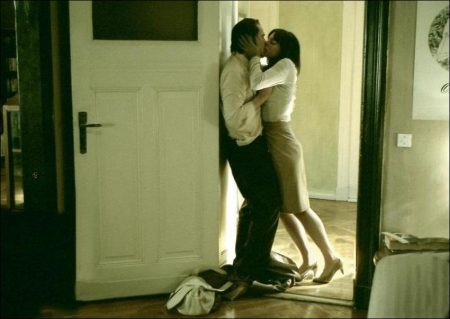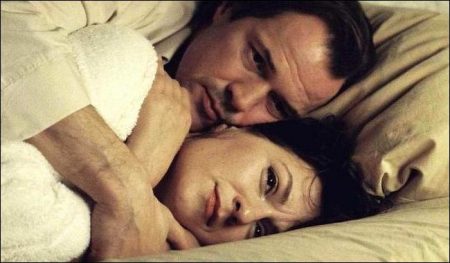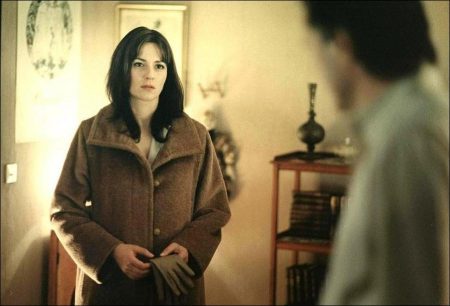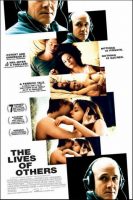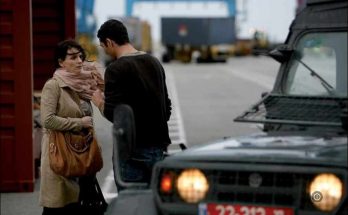What was the genesis of the project and is it based on personal experiences?
The Lives of Others Movie Trailer. Over the years, there were two things that led me to make the film. First were many childhood memories of my visits to East Berlin and the GDR. As a boy of eight, nine or ten, I found it interesting and exciting to feel the fear of adults. My parents were afraid when they crossed the border: they were both born in the East and thus were more closely controlled by the police. And our friends from East Germany were afraid when other people saw that they were speaking with us, Germans from the West. Without these early experiences I would have had trouble finding the right approach.
There was an image I saw in film school that I was never able to forget: the close-medium shot of a man sitting in a bleak room, wearing headphones and listening to beautiful music even though he did not want to hear it. This man pursued me in my dreams and evolved over the years into Captain Gerd Wiesler.
You conducted intensive research for this film – how and where?
My research took four years. I went to many places where you can still feel the spirit of the past. A key location is the Hohenschönhausen Memorial or the former Ministry for State Security in Normannenstrasse. That’s where the former Stasi headquarters are located. Today it is called the Research Agency and Memorial as well as the Birthler Bureau and its archives.
Places can store emotions and these visits often gave me more than the many books that I read, and the documentaries that I watched. What was decisive however, were the conversations with eyewitnesses, from Stasi Lieutenant Colonel Wolfgang Schmidt, the head of the Evaluation and Control Group of the “HA XX,” (code names for the Stasi spies) to Stasi prostitutes and people who spent up to two years in Stasi detention centers.
I was advised on historical matters by a number of experts, including Prof. Manfred Wilke, head of the Research Committee on the SED (Sozialistische Einheitspartei Deutschlands: Socialist Unity Party of Germany) Regime; Jörg Drieselmann, head of the Research Agency and Memorial in Normannenstrasse, and Stasi colonel Wolfgang Schmidt.
I tried to get as many perspectives as possible and heard many contradictory stories – but in the end, I felt I had obtained a very definite feel for the era and its problems. The last and most important element was provided by my work with the actors and crewmembers. Most of them came from the East and brought with them many personal experiences and viewpoints.
For instance, Ulrich Muhe who plays Captain Gerd Wiesler found out after the Wall came down that he has been a Stasi victim, spied on in the 1980s by his then wife. She had met regularly with the Stasi and spied on Muhe, one of Germany’s best-known actors, in addition to other actors. She has denied the claims and said the Stasi invented the file on her. She has also won an injunction to halt publication of the book detailing the claims. The power of denial is amazing. There’s a 254 pages file detailing her involvement with the Stasi for which she was an informer for 10 years!
Thomas Thieme, who plays the minister, left East Germany in the 1980s, but his life was made hell once he applied to leave the country. Volkmar Kleinert who plays director Albert Jerska was asked by the Stasi to become an informer. He told me that the Stasi really made it sound as if he did not cooperate, he would have no career. When they called him on the appointed hour to find out his decision, Kleinert shouted “No!” into the phone and hung up. They never bothered him again and he ended up becoming a very prominent actor.
Another actor, Charly Hubner, invited his father to the premiere of the film. He was photographed with him and that photo appeared in the press. Because of that, many people identified the father as a Stasi officer. His father felt almost liberated by it after 20 years of keeping it secret. Now he is going from door to door apologizing to people he damaged through his activities. And for others, my research and the shooting were the occasion to speak about these things for the very first time, fourteen years after reunification. Some wounds truly take a very long time to heal.
Were there specific models for characters or events?
The characters were compiled from many different real-life figures, and many people will certainly be able to identify with one or the other character. But the film is not a “roman à clef” or a “film à clef.” Certain details about characters and events were deliberately left out. For example, Hempf is a minister without a portfolio. To me, what was important was not to lose myself in historical details but to tell a story about real people with an emotional viewpoint.
Can you talk about shooting in original former GDR locations?
Part of the quest for authenticity went into shooting in as many original locations as possible. Among the venues we chose were the former Stasi headquarters in Normannenstrasse – a feared address during the years of the SED regime. The scenes with Ulrich Tukur (as Lieutenant Colonel Anton Grubitz) were shot there. His office was directly next to that of Stasi boss Mielke. The finish of the GDR furniture in these offices had even been preserved. With their typical wood paneling, these offices have a unique look, which can be clearly assigned to a particular time and style – a situation that is both exciting and oppressive.
The production was also the first and is, to this day, the only feature film allowed to shoot in the original file-card archives of the former Stasi headquarters with the special authorization of Marianne Birthler, (the Head of the Federal Authority for Documents of the State Security Service of the Former GDR.)
The archive was a gigantic mechanical filing system, which has been restructured and digitalized since the shooting was completed. The data are preserved, but the location of the files and documents no longer exists in the form shown in the film. Although the film relates to events that took place only fifteen years ago, much has changed since then. One of the challenges was the painting over of graffiti, which is nowadays found everywhere. No sooner had the graffiti been painted over than they reappeared the following morning.
What was your approach with respect to sound, set design and color schemes?
To capture the atmosphere of East Berlin, we did not record in digital but in analog in order to convey a sense of “reduced calm.” Set designer Silke Buhr and I had a very definite idea about the color scheme. The GDR had its own world of colors and forms. The cars and fabrics were pale and desaturated. We proceeded through reduction. Since there was more green than blue in the GDR, we completely omitted blue.
There was also more orange than red, so we eliminated red. We consistently used certain shades of brown, beige, orange, green and gray to try and be as authentic as possible to what life under the GDR looked like. Emptiness is an aesthetically neutral condition. The streets of East Berlin are filmed almost empty, exactly as they were during those years. The local Kneipe, or pub, is almost empty; the canteen for the Stasi employees is Spartan. Wiesler’s apartment, a “plattenbau” (or high-rise apartment the Communists built during the 70s) is devoid of any sense of being a home.
Wiesler’s world actually starts to open when he begins spying on the actors who live in a charming Altbau, a typical old Berlin apartment with big rooms, high ceilings and creaky wooden floors. When he is perched above their apartment, using the attic as his listening post, I wanted to conveythat his worldview was challenged. We did not want an overload of “GDR props.” For me, the set design has to deliver the perfect background for the emotions of the actors – no more, but also no less. I don’t want the viewer to start thinking about individual props instead of emotionally connecting with the characters.
How did you manage to recruit Oscar winner Gabriel Yared to write the film score?
It took quite a bit of time, but I don’t take no for an answer! I had written my final film school project on “The Talented Mr. Ripley” (with a score written by Yared) and always had the feeling that I had only come to understand the film through the music. I kept writing to Gabriel until I was finally able to meet him. He is a native French speaker and we gave him a translation of the script at an early phase. We had several conversations in Paris and Londonand he got really interested.
Yared’s work method involves writing music for a film during the script phase. We got together three times in London in order to work on this together. For instance, he composed the “Sonata for a Good Man,” that Dreyman plays, before we started to shoot. Interestingly, Sebastian Koch said that he only truly understood how to play Dreyman after playing this piece, which shows that Gabriel’s method makes sense! The music was recorded in Prague with the Prague Symphony Orchestra, which is considered one of the best in the world.
The Lives of Others (2007)
Directed by: Florian Henckel von Donnersmarck
Starring: Martina Gedeck, Ulrich Muehe, Sebastian Koch, Ulrich Tukur, Thomas Thieme, Volkmar Kleinert. Matthias Brenner, Marie Gruber, Volker Michalowski, Werner Daehn
Screenplay by: Florian Henckel von Donnersmarck
Production Design by: Silke Buhr
Cinematography by: Hagen Bogdanski
Film Editing by: Patricia Rommel
Costume Design by: Gabriele Binder
Set Decoration by: Frank Noack
Art Direction by: Christiane Rothe
Music by: Stéphane Moucha, Gabriel Yared
MPAA Rating: R for some sexuality and nudity.
Studio: Sony Pictures Classics
Release Date: February 9, 2007
Views: 99
